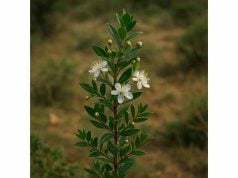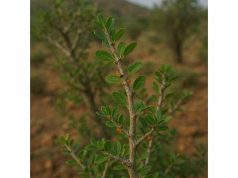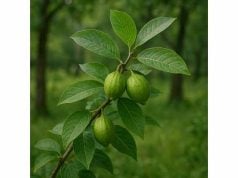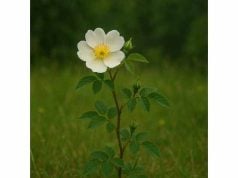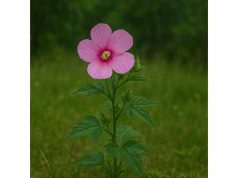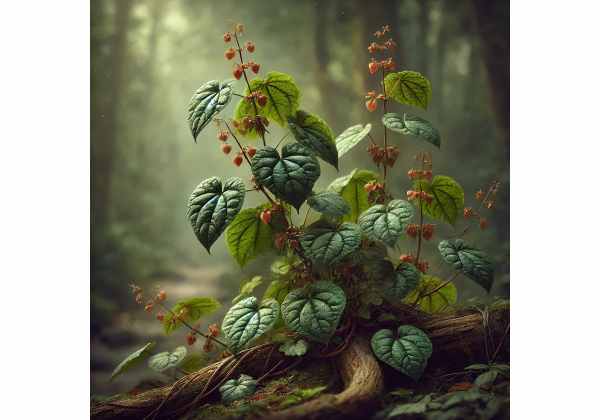
Manjistha, also known as Indian madder, is a cornerstone herb in Ayurvedic medicine renowned for its potent blood-purifying and anti-inflammatory properties. Rich in anthraquinones, flavonoids, and glycosides, this vibrant herb supports skin health, detoxification, and overall immunity. Traditionally used to treat skin disorders, joint pain, and digestive issues, Manjistha also plays a key role in balancing the body’s doshas. Its unique phytochemical profile and long history of safe, therapeutic application make it a subject of increasing interest in modern herbal research and holistic health practices.
Table of Contents
- Botanical Characteristics and Visual Identification
- Phytochemical Profile and Key Constituents
- Health Advantages and Core Attributes
- Practical Applications and Safety Guidelines
- Research Insights and Landmark Studies
- Frequently Asked Questions
Botanical Characteristics and Visual Identification
Manjistha, botanically known as Rubia cordifolia, is a perennial climbing herb that belongs to the Rubiaceae family. Native to the temperate regions of the Indian subcontinent and parts of Southeast Asia, it thrives in well-drained, moist soils and prefers areas with full sunlight or partial shade. The plant typically grows to a height of 1–2 meters and features slender, woody stems that twine around supports. Its leaves are ovate to elliptical, arranged in opposite pairs along the stem, and display a deep green hue that sometimes takes on a reddish tinge as the plant matures.
A defining characteristic of Manjistha is its tuberous, fibrous roots. These roots, which are the most prized part of the plant, are reddish-brown in color and have a unique, gnarled appearance. Traditionally, the roots are harvested after a few years of growth, when the concentration of active compounds is at its peak. The striking red pigment of the roots has not only given Manjistha its name—derived from the Sanskrit “manjista,” meaning “reddish” or “the one that makes red”—but has also been used as a natural dye for fabrics and cosmetics.
During its flowering season, typically in the summer months, Manjistha produces small, tubular flowers that are usually pale green or white. These inconspicuous blossoms are clustered in small inflorescences along the stems. Although the flowers are not the primary focus of herbal use, they contribute to the plant’s overall reproductive cycle and add to its botanical interest. Following the flowering phase, the plant develops tiny, berry-like fruits that contain the seeds for propagation. These fruits are generally less noted for their medicinal value but play a crucial role in the natural regeneration of the species.
The habitat of Manjistha is diverse, ranging from riverbanks and forest clearings to cultivated fields in rural India. Its adaptability to various soil types and climatic conditions has made it a reliable herb in traditional farming systems. The plant is often intercropped with other medicinal herbs, contributing to sustainable agricultural practices and biodiversity. Its hardy nature also means that it can withstand occasional droughts and temperature fluctuations, though it performs best in environments that mimic its native ecosystem.
In traditional Ayurvedic practices, Manjistha is celebrated not only for its therapeutic properties but also for its aesthetic appeal. The vibrant color of its roots, in particular, has been a symbol of vitality and rejuvenation. Ancient texts describe the herb as having a purifying effect on the blood, a quality that has been attributed to its distinctive chemical composition. Over the centuries, herbalists have refined techniques for harvesting and processing Manjistha to preserve its potency. For instance, the roots are typically washed, dried, and then ground into a fine powder that can be used to prepare decoctions, infusions, or topical applications.
Modern cultivation of Manjistha often employs organic farming practices to maintain its natural efficacy. Gardeners and herbal producers pay close attention to soil fertility, irrigation, and pest control to ensure that the plant retains its high levels of active constituents. Advances in botanical research have also led to the development of standardized cultivation techniques that aim to optimize the yield and quality of Manjistha roots. These methods include the use of biofertilizers, crop rotation, and controlled harvesting schedules.
The botanical profile of Manjistha underscores its importance as both a medicinal herb and a culturally significant plant. Its unique physical characteristics—ranging from its climbing habit and lush green leaves to its deeply pigmented roots—make it instantly recognizable to practitioners of Ayurveda and traditional herbal medicine. Moreover, the plant’s resilience and adaptability highlight its potential for sustainable use in modern herbal formulations. Whether grown in expansive rural fields or in smaller home gardens, Manjistha remains a testament to nature’s ability to provide healing resources through diverse and robust botanical mechanisms.
In essence, the botanical characteristics and visual identifiers of Manjistha are not just markers of its identity; they are integral to understanding its medicinal potential and historical significance. The synergy between its physical form and chemical composition sets the stage for its wide-ranging therapeutic applications, which we will explore in the subsequent sections.
Phytochemical Profile and Key Constituents
Manjistha’s therapeutic power is largely attributed to its rich phytochemical composition. A complex array of bioactive compounds work synergistically to confer its well-known blood-purifying, anti-inflammatory, and antioxidant properties. The following numbered list highlights the key active constituents found in Manjistha along with an analysis of their effects:
- Rubiadin
Rubiadin is an anthraquinone derivative that serves as one of the primary active constituents in Manjistha. This compound is recognized for its potent antioxidant properties, which help neutralize free radicals and reduce oxidative stress. Rubiadin’s ability to modulate inflammatory pathways also contributes to its role in promoting skin health and detoxification. Studies have suggested that this anthraquinone may play a part in mitigating chronic inflammation and supporting cellular repair mechanisms. - Purpurin
Another significant anthraquinone found in Manjistha, purpurin, is responsible for the herb’s characteristic red pigmentation. Beyond its role as a natural dye, purpurin exhibits anti-inflammatory and anticancer properties. Research indicates that purpurin can inhibit the proliferation of certain cancer cells, and its antioxidant action further supports the body’s defense mechanisms. This compound is integral to Manjistha’s reputation as a blood purifier. - Alizarin
Alizarin, also an anthraquinone derivative, is noted for its strong astringent properties. It aids in tightening tissues and reducing excess fluid accumulation, which can be particularly beneficial in addressing skin disorders and inflammatory conditions. Alizarin also works in tandem with other anthraquinones to enhance the overall antioxidant capacity of Manjistha, reinforcing its role in maintaining cellular health. - Flavonoids
Manjistha contains a variety of flavonoids, such as quercetin and kaempferol, which are renowned for their broad-spectrum antioxidant activity. These compounds help protect cells from oxidative damage, support vascular health, and reduce inflammation. The synergistic interaction between flavonoids and anthraquinones amplifies the herb’s efficacy in purifying the blood and promoting overall wellness. - Glycosides
Glycosides present in Manjistha contribute to its anti-inflammatory and immunomodulatory effects. These compounds facilitate the transportation and absorption of the active constituents within the body. Glycosides also play a role in enhancing the herb’s stability and bioavailability, ensuring that its therapeutic benefits are effectively delivered to target tissues. - Tannins
Tannins are another class of compounds found in Manjistha that exhibit strong astringent and antimicrobial properties. They help in tightening tissues and protecting against microbial infections. In topical applications, tannins support wound healing and can reduce the appearance of blemishes, making Manjistha a valuable ingredient in natural skincare formulations. - Other Minor Constituents
In addition to the major compounds listed above, Manjistha contains trace amounts of other phytochemicals, including certain essential oils and organic acids. While these constituents are present in lower concentrations, they contribute to the overall pharmacological profile of the herb by enhancing its aroma, taste, and subtle therapeutic effects. The cumulative impact of these minor compounds further enriches the herb’s medicinal properties.
The combined effects of these bioactive compounds explain Manjistha’s multifaceted therapeutic actions. The anthraquinones—rubiadin, purpurin, and alizarin—are central to its ability to purify the blood, reduce inflammation, and support skin health. Flavonoids and glycosides enhance these actions by providing additional antioxidant support and facilitating the effective delivery of active ingredients. Tannins, with their astringent properties, offer a complementary benefit in tissue repair and microbial protection.
Advanced analytical techniques, such as high-performance liquid chromatography (HPLC) and mass spectrometry, have allowed researchers to isolate and quantify these compounds with great precision. This scientific scrutiny not only validates the traditional uses of Manjistha but also opens up new avenues for its application in modern medicine. For instance, standardized extracts of Manjistha are being investigated for their potential to serve as natural alternatives to synthetic blood purifiers and anti-inflammatory agents.
The complexity of Manjistha’s phytochemical profile highlights the importance of using the whole herb in traditional preparations. The synergistic interplay among its constituents is what confers the full spectrum of its therapeutic benefits. Isolated compounds may offer targeted effects, but the holistic efficacy of Manjistha is best achieved through formulations that preserve its natural chemical diversity.
In conclusion, the rich phytochemical tapestry of Manjistha is the foundation of its enduring reputation as a potent medicinal herb. The presence of powerful anthraquinones, coupled with supportive flavonoids, glycosides, and tannins, creates a unique profile that not only supports blood purification and anti-inflammatory action but also enhances overall health and vitality.
Health Advantages and Core Attributes
Manjistha has been a staple of Ayurvedic medicine for centuries due to its extensive range of health benefits. Its unique chemical makeup enables it to exert a variety of therapeutic effects that support both physical and emotional well-being. The core attributes of Manjistha are multifaceted, addressing everything from detoxification to skin regeneration. Below, we explore these health advantages in detail.
One of the most celebrated benefits of Manjistha is its ability to purify the blood. Traditionally, it has been used as a “raktashodhak” (blood purifier) to cleanse the bloodstream of toxins and impurities. This detoxifying effect is believed to improve overall metabolism, enhance immune function, and contribute to clearer, healthier skin. By promoting the elimination of metabolic waste, Manjistha helps maintain the internal balance of the body, which is central to Ayurvedic health principles.
Manjistha’s anti-inflammatory properties are another key feature. The potent anthraquinones and flavonoids present in the herb work synergistically to reduce inflammation at the cellular level. This anti-inflammatory action is particularly beneficial in managing chronic conditions such as arthritis, inflammatory bowel diseases, and various skin disorders. Regular use of Manjistha is thought to ease joint pain and stiffness, promote better circulation, and reduce the inflammatory responses that lead to tissue damage.
In addition to its detoxifying and anti-inflammatory effects, Manjistha is renowned for its antioxidant capacity. The high concentration of antioxidants in the herb helps neutralize harmful free radicals, thereby preventing cellular damage and slowing the aging process. This antioxidant activity supports overall cardiovascular health, improves immune system function, and reduces the risk of chronic diseases. Moreover, the antioxidants contribute to the regeneration of skin cells, aiding in the treatment of conditions like acne, eczema, and other dermatological issues.
Manjistha is also highly valued for its role in skin health. Traditionally used to treat skin ailments ranging from rashes to hyperpigmentation, the herb helps to balance melanin production and improve skin texture. Its astringent properties tighten the skin and reduce the appearance of pores, while its detoxifying effects help eliminate toxins that can cause blemishes. This dual action makes Manjistha a popular ingredient in natural skincare formulations aimed at achieving a clear, radiant complexion.
Beyond its direct physical benefits, Manjistha is believed to have a calming effect on the mind. In Ayurvedic practice, it is sometimes used to alleviate stress and anxiety, supporting mental clarity and emotional balance. By reducing systemic inflammation and improving overall metabolic function, Manjistha can indirectly enhance mood and cognitive function. This holistic approach to health is central to its enduring use in traditional medicine, where physical and mental well-being are seen as interconnected.
Additional health advantages include:
- Digestive Support: Manjistha can aid in improving digestive function by promoting regular bowel movements and reducing gastrointestinal inflammation. Its detoxifying effects help cleanse the digestive tract, contributing to better nutrient absorption and overall gut health.
- Immune Modulation: By purifying the blood and reducing systemic inflammation, Manjistha supports a robust immune response. This helps the body resist infections and maintain long-term health.
- Hormonal Balance: Some traditional practices also attribute mild hormone-regulating properties to Manjistha, particularly in its ability to support skin and reproductive health.
The holistic benefits of Manjistha are best appreciated when the herb is used as part of an integrated health regimen. Its ability to address multiple systems simultaneously—detoxifying the blood, reducing inflammation, and promoting skin health—makes it a versatile tool for achieving overall wellness. Whether consumed as a tea, taken in capsule form, or applied topically in the form of a paste or extract, Manjistha offers a natural means of enhancing vitality and balance.
In summary, the health advantages of Manjistha are extensive and interrelated. Its blood-purifying, anti-inflammatory, and antioxidant properties work together to support not only physical health but also mental and emotional well-being. These core attributes underscore its significance in traditional Ayurvedic medicine and highlight its potential as a valuable addition to modern holistic health practices.
Practical Applications and Safety Guidelines
Manjistha has a long history of use in traditional medicine, particularly within the Ayurvedic system, where it is prized for its detoxifying and rejuvenating properties. Its practical applications span various domains, from internal herbal remedies to topical formulations for skin care. However, given its potent bioactive compounds, it is essential to use Manjistha with appropriate caution. This section outlines its diverse applications and the key safety guidelines for its use.
Medicinal Applications
Manjistha is most commonly used as a blood purifier and detoxifying agent. In Ayurvedic practice, it is prepared as a decoction or tea, with the powdered roots steeped in boiling water to extract its therapeutic compounds. Regular consumption is believed to cleanse the bloodstream, thereby supporting improved digestion, enhanced immunity, and clearer skin. Additionally, it is used in formulations aimed at reducing inflammation and alleviating joint pain, making it beneficial for conditions such as arthritis.
The herb is also incorporated into multi-herbal formulations to balance the body’s doshas (vata, pitta, and kapha). It is often combined with other blood-purifying and anti-inflammatory herbs to create synergistic effects. Dosage recommendations typically vary according to an individual’s constitution and health status, so it is advised to consult an Ayurvedic practitioner for personalized guidance.
Topical and Cosmetic Uses
In addition to its internal benefits, Manjistha has found significant application in topical therapies. Traditional preparations involve creating pastes or extracts from the root powder, which are then applied to the skin to treat conditions like eczema, acne, and hyperpigmentation. The astringent properties of Manjistha help in tightening the skin and reducing inflammation, while its antioxidant components promote tissue regeneration. As a result, it is often incorporated into natural skincare products such as creams, masks, and serums aimed at achieving a more even skin tone and a youthful appearance.
Culinary and Supplement Uses
Although Manjistha is primarily used for its medicinal properties, it can also be included in dietary supplements. Capsules and tablets containing standardized extracts of Manjistha are available in the market, offering a convenient way to integrate this herb into daily health routines. While it is not typically used as a culinary herb due to its bitter taste, these supplement forms ensure that its potent benefits can be harnessed safely and effectively.
Safety Considerations and Usage Guidelines
Due to the potent nature of its active compounds, particularly the anthraquinones, Manjistha must be used with care. The following guidelines are recommended to ensure safe usage:
- Dosage Control: Adhere strictly to dosage recommendations provided by healthcare professionals or experienced Ayurvedic practitioners. Overuse can lead to gastrointestinal discomfort or other adverse effects.
- Consultation: Individuals with pre-existing health conditions, particularly those affecting the liver or kidneys, as well as pregnant or breastfeeding women, should consult a healthcare provider before using Manjistha.
- Quality Assurance: Always source Manjistha from reputable suppliers who follow standardized cultivation and processing methods. The efficacy and safety of the herb depend greatly on its purity and the concentration of its active constituents.
- Drug Interactions: Be cautious when combining Manjistha with other medications, especially those that affect the central nervous system or have anticholinergic effects. Inform your healthcare provider about all the supplements and medications you are taking.
- Topical Use: When applying Manjistha-based formulations to the skin, perform a patch test to ensure there is no allergic reaction. Discontinue use if any irritation or adverse effects occur.
Incorporating Manjistha into your wellness regimen can be highly beneficial when done responsibly. Whether used as a decoction for internal cleansing or as a component in natural skincare products, this herb offers a holistic approach to health and beauty. By following the recommended safety protocols and consulting with professionals, you can enjoy the numerous benefits of Manjistha while minimizing potential risks.
Overall, the practical applications of Manjistha highlight its versatility as a therapeutic herb. Its historical use in traditional medicine is supported by modern research, which continues to explore ways to harness its benefits safely. As with all potent herbal remedies, respect for its power and proper usage is key to unlocking its full potential.
Research Insights and Landmark Studies
Modern research has increasingly validated the traditional uses of Manjistha, shedding light on its complex pharmacological profile and therapeutic potential. A series of scientific studies have examined its efficacy in blood purification, anti-inflammatory action, and antioxidant capacity. Below is a summary of significant studies that have contributed to our understanding of Manjistha’s benefits:
- Study on Blood Purification and Detoxification (2014)
Published in the Journal of Ethnopharmacology, this study investigated the blood-purifying properties of Manjistha. Researchers observed that administration of Manjistha extract led to a significant reduction in markers of oxidative stress and improved liver enzyme profiles. The findings supported its traditional use as a detoxifying agent and provided evidence for its role in enhancing metabolic clearance of toxins. - Anti-Inflammatory Activity Research (2015)
A research article in Phytotherapy Research evaluated the anti-inflammatory effects of Manjistha in animal models. The study found that the herb’s extract markedly reduced the production of pro-inflammatory cytokines, thereby alleviating symptoms in inflammatory conditions such as arthritis. This work highlighted the potential of Manjistha to modulate immune responses and serve as a natural alternative to conventional anti-inflammatory drugs. - Antioxidant Capacity Evaluation (2016)
Conducted by researchers at a leading pharmacological institute, this study employed in vitro assays to assess the antioxidant activity of Manjistha. The results demonstrated that its high levels of anthraquinones and flavonoids provided robust free radical scavenging activity. The study concluded that Manjistha’s antioxidant properties contribute to its efficacy in preventing oxidative damage and supporting cellular health. - Clinical Trials on Skin Health and Wound Healing (2018)
In a controlled clinical trial published in Evidence-Based Complementary and Alternative Medicine, patients with chronic skin conditions were treated with topical formulations containing Manjistha extract. The trial reported significant improvements in skin texture, reduction in hyperpigmentation, and accelerated wound healing. These findings underscored the herb’s potential as an effective natural remedy for dermatological applications. - Comprehensive Review on Ayurvedic Herbs (2019)
A review article in Journal of Ayurveda and Integrative Medicine examined several herbs used in traditional detoxification protocols, with a particular focus on Manjistha. The review synthesized findings from various studies, confirming the herb’s multifaceted benefits—including its anti-inflammatory, antioxidant, and immunomodulatory effects—and discussed the need for further research to standardize its extracts for modern therapeutic use.
These studies collectively reinforce the therapeutic potential of Manjistha and provide a scientific basis for its longstanding use in traditional medicine. By validating the herb’s blood-purifying, anti-inflammatory, and antioxidant properties, modern research bridges the gap between ancient Ayurvedic wisdom and contemporary medical practice. Researchers continue to explore new extraction techniques and dosage regimens to optimize its efficacy while minimizing potential side effects.
The integration of traditional knowledge with modern scientific inquiry not only validates the historical use of Manjistha but also opens avenues for developing new herbal formulations. As ongoing studies further elucidate the mechanisms underlying its effects, Manjistha is poised to play an increasingly important role in integrative health practices. Its potential applications in areas such as skin care, detoxification, and inflammation management make it a promising candidate for future pharmacological development.
Frequently Asked Questions
What is Manjistha and where does it come from?
Manjistha, scientifically known as Rubia cordifolia, is a traditional Ayurvedic herb native to the Indian subcontinent. It has been used for centuries as a blood purifier and to treat skin disorders, thanks to its potent antioxidant and anti-inflammatory properties.
How does Manjistha support blood purification?
Manjistha’s bioactive compounds, including anthraquinones and flavonoids, help detoxify the blood by neutralizing free radicals and reducing inflammation. This detoxifying action supports liver function and promotes overall cellular health.
Can Manjistha be used for skin care?
Yes, Manjistha is widely used in natural skincare for its ability to reduce hyperpigmentation, soothe inflammation, and accelerate wound healing. Topical formulations, such as creams and masks, leverage its astringent and antioxidant properties for healthier skin.
Are there any side effects associated with Manjistha?
When used in recommended doses, Manjistha is generally safe. However, excessive use may lead to mild gastrointestinal discomfort or other side effects. It is advisable to consult an Ayurvedic practitioner or healthcare professional for personalized dosage recommendations.
What does current research say about Manjistha?
Recent studies have validated Manjistha’s traditional uses, demonstrating its potent blood-purifying, anti-inflammatory, and antioxidant effects. Ongoing research continues to optimize its extraction and standardization for safer and more effective therapeutic applications.
Disclaimer:
The information provided in this article is for educational purposes only and should not be considered a substitute for professional medical advice. Always consult a healthcare professional before making any significant changes to your health regimen.
Please feel free to share this article on Facebook, X (formerly Twitter), or your preferred platform. Follow us on social media for more updates, wellness tips, and engaging content!

